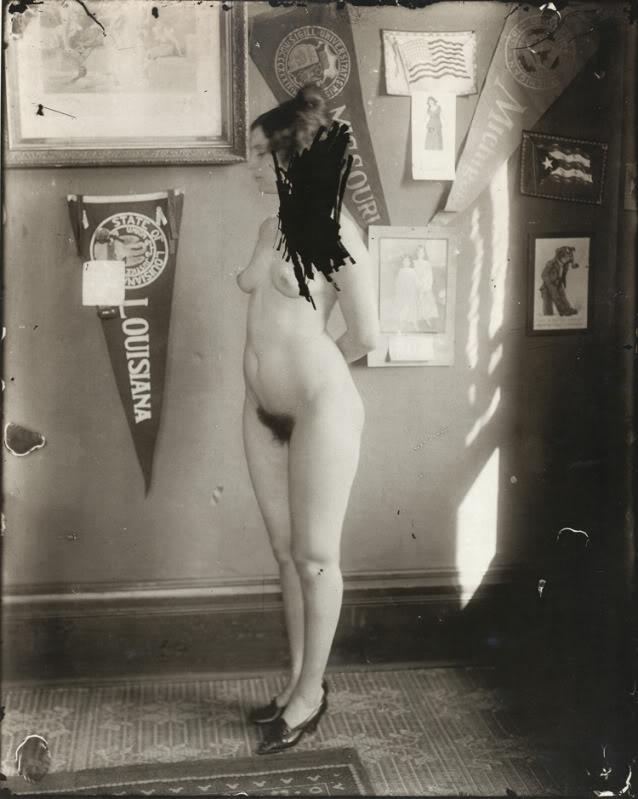
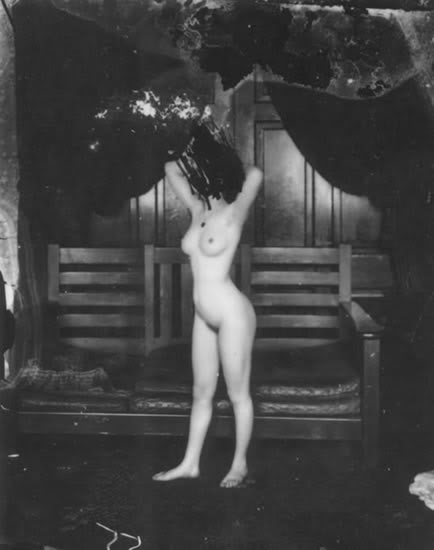

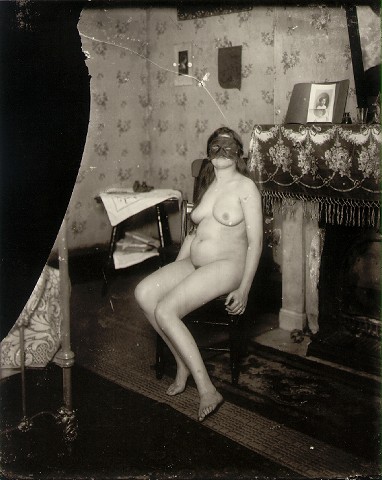


Storyville was the legendary red-light district of New Orleans, which famously legalized prostitution between 1898-1917. After its abolition in 1918, the buildings were almost entirely torn down, from the expensive high-class mansions to the cheap “cribs”. Today, little remains of this once “unofficial American capital of vice”, where madams had the status of local celebrities and the first notes of jazz were played.
 Some of the only visual evidence that exists from Storyville are these haunting images of prostitutes, taken in the first two decades of the 20th century by an obscure photographer named E. J. Bellocq. These photographs were a secret side project of Bellocq, who made his living photographing far more banal things like landmarks and ships for local companies. Hidden in a sofa until after Bellocq’s death, the glass negatives we thrust into the consciousness of the art world in 1970, when they were acquired by artist Lee Friedlander, who reprinted the Storyville images as part of an exhibition at MoMA in New York.
Some of the only visual evidence that exists from Storyville are these haunting images of prostitutes, taken in the first two decades of the 20th century by an obscure photographer named E. J. Bellocq. These photographs were a secret side project of Bellocq, who made his living photographing far more banal things like landmarks and ships for local companies. Hidden in a sofa until after Bellocq’s death, the glass negatives we thrust into the consciousness of the art world in 1970, when they were acquired by artist Lee Friedlander, who reprinted the Storyville images as part of an exhibition at MoMA in New York.
 Perhaps the most unsettling element of these pictures are the mysteriously scratched out faces of many of the prostitutes. Although some have speculated that this was the work of E J Bellocq’s brother, a Jesuit priest who inherited the negatives, experiments by Lee Friedlander proved that the scratching had to have taken place during the processing of the negatives; hence, E J Bellocq must have been the de-facer.
Perhaps the most unsettling element of these pictures are the mysteriously scratched out faces of many of the prostitutes. Although some have speculated that this was the work of E J Bellocq’s brother, a Jesuit priest who inherited the negatives, experiments by Lee Friedlander proved that the scratching had to have taken place during the processing of the negatives; hence, E J Bellocq must have been the de-facer.
Why scratch out the faces? In other photographs, many of the women wear masks, presumably to hide their identity; could this be the motivation? And was this at the request of his models? Despite making a  living selling their bodies, did some of the Storyville prostitutes draw the line at surrendering their image? Or, did the masking and scratching come from Bellocq? Perhaps it was more about an extreme fetishisation of the body, completely divorced from an identity or humanity? To the best of anyone’s knowledge, these photographs were never circulated or sold for profit by Bellocq. They were his private encounters; could the taking of each pictures be considered a sort of sex act in itself? His unsettling images open up more questions than they answer.
living selling their bodies, did some of the Storyville prostitutes draw the line at surrendering their image? Or, did the masking and scratching come from Bellocq? Perhaps it was more about an extreme fetishisation of the body, completely divorced from an identity or humanity? To the best of anyone’s knowledge, these photographs were never circulated or sold for profit by Bellocq. They were his private encounters; could the taking of each pictures be considered a sort of sex act in itself? His unsettling images open up more questions than they answer.
One last interesting fact: Bellocq was often described as “insane, hunchbacked, grotesque, dwarfish, or hydrocephalic”. His physical aberration is perhaps what allowed him to move freely as a social outsider within this world of social outsiders. Could his gesture of scratching the face be a reaction to the experience of his own corporeal experience? Bellocq’s photographs, as well as his treatment and relationship to the body, have had a major influence on many contemporary photographers: for example, check out the grotesque and stylized photographic tableaux of Joel-Peter Witkin here and here, who was strongly influenced by Bellocq and his legend.



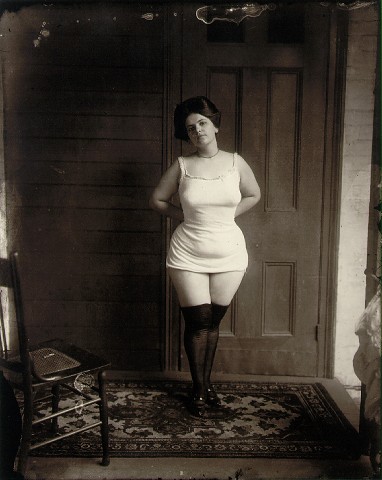

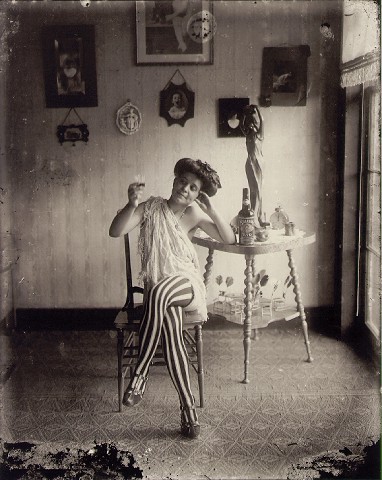

// Images from Things Unsaid Then Forgotten, Oda a Niepce, Studio SPG, and Masters of Photography.
Elsewhere on the Museum of Ridiculously Interesting Things:

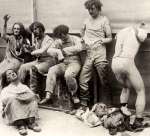
I didn’t see this in the comments so I thought
I’d chime in with a bit of trivia. There was a Hollywood movie, Pretty Baby, based on Bellocq’s Storyville photography. Brooke Shields and Susan Sarandon starred in it.
I recently found a stamped image of the lady in striped stockings looking at a glass.
Was this article eventually published? I found it on your academia profile and would like to cite it. Thank you! :)
Was this article eventually published? I found it on your academia profile and would like to cite it for a presentation. Thank you :)
Pingback: She lived in someone’s locket | The Museum of Ridiculously Interesting Things
Because photography was still not considered “art” at the turn of the century could these women have been photographed to be used as models for paintings by other artists? That might account for the lack of asthetic in the backgrounds and the attempt at annonimity for some. He (Bellocq) was better known for commercial photography during his career and might very well have sold single prints to artists/painters because it was cheaper and easier than having a live subject pose for the actual use.
Pingback: GUEST POST: Mrs Marvel on ‘Things I’m Glad Are Out of Style’ | The Museum of Ridiculously Interesting Things
Pingback: The life of New Zealand’s latest criminal celebrity: the ridiculously photogenic Daniel Tohill (Lohill) | The Museum of Ridiculously Interesting Things
Perhaps Belloq had to promise the girls he would scratch their faces out to preserve their annonymity before some of them would let him take their picture.
Pingback: Burnt and melted wax figures after the 1925 fire at Madame Tussauds in London | The Museum of Ridiculously Interesting Things
Pingback: Hidden mothers in Victorian portraits | The Museum of Ridiculously Interesting Things
Pingback: Art Direction – Joel Peter Witkin « phildawsonphotography
I’m sure more than one person noticed. I did, I just didn’t want to run the risk of being rude to you on your own post by pointing it out. Everybody knew what you meant, lol! Thanks for posting these great pics!
Um…
“Hidden in a sofa until after his death, Bellocq was made internationally famous in the 1970s when artist Lee Friedlander got his hands on Bellocq’s glass negatives and reprinted the images as part of a major show at the Museum of Modern Art in New York.”
Bellocq was hidden in a sofa until after his death?! Amazing! How, then, did he manage to make these photographs?
Hehe I noticed that grammatical error after I published the post and was waiting to see if anyone would pick it up. You win the prize! It’s more fun the wrong way though, don’t you think?
Toulouse-Lautrec comes to mind.